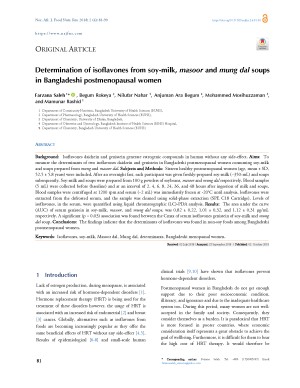Determination of isoflavones from soy-milk, masoor and mung dal soups in Bangladeshi postmenopausal women
Abstract
Background: Isoflavones daidzein and genistein generate estrogenic compounds in human without any side-effect. Aims: To measure the determinants of two isoflavones daidzein and genistein in Bangladeshi postmenopausal women consuming soy-milk and soups prepared from mung and masoor dal. Methods and Material: Sixteen healthy postmenopausal women (age, mean±SD, 52.5±5.8 years) were included. After an overnight fast, each participant was given freshly-prepared soy-milk (~350-mL) and soups subsequently. Soy-milk and soups were prepared from 100 g powders of soybeans, masoor and mung dal respectively. Blood samples (5 mL) were collected before (baseline) and at an interval of 2, 4, 6, 8, 24, 36, and 48 hours after ingestion of milk and soups. Blood samples were centrifuged at 1200 rpm and serum (~2 mL) was immediately frozen at -20°C until analysis. Isoflavones were extracted from the defrosted serum, and the sample was cleaned using solid-phase extraction (SPE C18 Cartridge). Levels of isoflavones, in the serum, were quantified using liquid chromatographic (LC)-PDA analysis. Results: The area under the curve (AUC) of serum genistein in soy-milk, masoor, and mung dal soups, was 0.82 ±0.22, 1.01 ±0.32, and 1.12 ±0.31 µg/mL respectively. A significant (P= 0.03) association was found between the Cmax of serum isoflavones genistein of soy-milk and mung dal soup. Conclusions: The findings indicate that the determinants of isoflavones was found in non-soy foods among Bangladeshi postmenopausal women. Isoflavones daidzein and genistein generate estrogenic compounds in human without any side-effect. Aims: To measure the determinants of two isoflavones daidzein and genistein in Bangladeshi postmenopausal women consuming soy-milk and soups prepared from mung and masoor dal. Methods and Material: Sixteen healthy postmenopausal women (age, mean±SD, 52.5±5.8 years) were included. After an overnight fast, each participant was given freshly-prepared soy-milk (~350-mL) and soups subsequently. Soy-milk and soups were prepared from 100 g powders of soybeans, masoor and mung dal respectively. Blood samples (5 mL) were collected before (baseline) and at an interval of 2, 4, 6, 8, 24, 36, and 48 hours after ingestion of milk and soups. Blood samples were centrifuged at 1200 rpm and serum (~2 mL) was immediately frozen at -20°C until analysis. Isoflavones were extracted from the defrosted serum, and the sample was cleaned using solid-phase extraction (SPE C18 Cartridge). Levels of isoflavones, in the serum, were quantified using liquid chromatographic (LC)-PDA analysis. Results: The area under the curve (AUC) of serum genistein in soy-milk, masoor, and mung dal soups, was 0.82 ±0.22, 1.01 ±0.32, and 1.12 ±0.31 µg/mL respectively. A significant (P= 0.03) association was found between the Cmax of serum isoflavones genistein of soy-milk and mung dal soup. Conclusions: The findings indicate that the determinants of isoflavones was found in non-soy foods among Bangladeshi postmenopausal women.
Full text article
Authors
Copyright (c) 2018 Authors

This work is licensed under a Creative Commons Attribution 4.0 International License.
-
Attribution — You must give appropriate credit, provide a link to the license, and indicate if changes were made. You may do so in any reasonable manner, but not in any way that suggests the licensor endorses you or your use.
-
No additional restrictions — You may not apply legal terms or technological measures that legally restrict others from doing anything the license permits.





